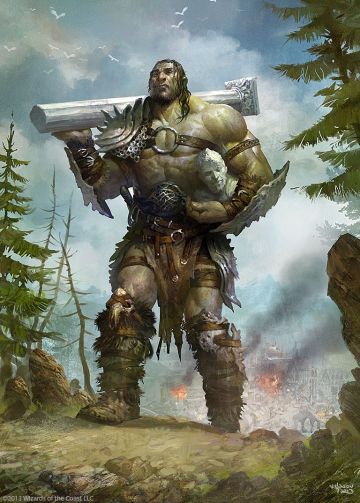Strength (ability stat)
Strength is an ability statistic that dictates the character's physical capacity in bringing force to bear, whether against an enemy or a physical object. A high strength enables the character to carry more weight, strike harder with weapons, lift or break objects with one's body and so on. Strength is a required prerequisite of fighters, paladins, rangers, assassins and monks.
Strength most commonly adjusts encumbrance and the player's success in combat. The to hit bonus (or modifier) may add or subtracts points from the d20 when the character attempts to hit with a weapon. If the hit occurs, then the amount of damage done by a weapon is adjusted by the damage bonus.
| Strength | To Hit Bonus | Damage Bonus |
|---|---|---|
| 3 | -3 | -2 |
| 4 | -2 | -1 |
| 5 | -1 | nil |
| 6-15 | nil | nil |
| 16 | nil | +1 |
| 17 | +1 | +1 |
| 18 | +1 | +2 |
| 18/(01-50) | +1 | +3 |
| 18/(51-75) | +2 | +3 |
| 18/(76-90) | +2 | +4 |
| 18/(91-99) | +2 | +5 |
| 18/00 | +3 | +6 |
| 19 | +3 | +7 |
| 20 | +3 | +8 |
| 21 | +4 | +9 |
| 22 | +4 | +10 |
| 23 | +5 | +11 |
| 24 | +6 | +12 |
| 25 | +7 | +14 |
- For example, a 1st level character with a 4 strength swings with a dagger. Rolling a d20, they get a result of 16, which would normally hit armour class 4. However, due to the character's low strength, the die is adjusted to a 14. If this hits, the character then rolls a d4 for the dagger's damage. If the character gets a result of a 1, then 1 is subtracted from this total and the character does no damage at all. Bonuses that add to the die work the same way.
Adjustment and Percentile Strength
Characters and creatures who are determined upon creation to have a "natural" 18 strength (without adjustments) are entitled to roll a percentile die to determine their exceptional strength (or, "percentile" strength). This roll, from 1 to 100, can add tremendous power to the character's combat force. Say a character rolls a "67" — the strength would be written out as "18/67." Comparing this with the table shown, "67" falls in the range of 51 and 75, so the character would be +2 to hit and +3 to damage.
For those without a natural 18, it's still possible through age or race, or through magic, for the character to attain a "modified strength of 18." When this occurs, the procedure is somewhat different.
- For example, a character with a "17" strength has their strength improved by 1 point, through age, spell or other means. Their new strength is now "18," without a "percentage." If this 18 strength is then increased one more point point, then 1% is added and the new strength becomes "18/01". Further point increases would improve the percentage by 10 points.
If a character already has a percentage strength, say "18/67," then a +1 strength modifier would increase this number to "18/77." Any number between "18/90" and "18/99" automatically becomes 18/00 when increased. When an 18/00 strength is augmented, it becomes a 19 strength, then proceeds upwards by one point at a time until a maximum of 25 strength is reached.
The 2nd level mage spell, strength, has the power to increase the strength ability stat by 1 to 8 points. The advancement of strength follows these adjustment rules as written above. A "17" strength improved by 8 points would progress to 18, 18/01, 18/11 and so on until 18/61. An "18/67" strength improved by 8 points would progress to 18/77, 18/87, 18/97, 18/00, 19, 20, 21 and finally to 22.
Maximum Strength
A strength of 19 is normally considered to be the highest natural strength that a player character race can obtain (without the intevention of magic. This includes humans, dwarves, elves, gnomes, halflings, half-elves and half-orcs). A character could conceivably obtain a 20 strength, by starting as a half-orc, rolling a natural 18 for strength, rolling a percentage of 100, then adding 1 point for their racial characteristic and a second point for being of mature age. This is highly unlikely, and a DM may choose to deny it. If it were to occur in my game, I would personally allow it.
